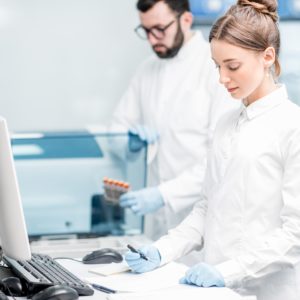Clinical Researcher—May 2019 (Volume 33, Issue 5)
GOOD MANAGEMENT PRACTICE
Christopher J. Ianelli, MD, PhD; Andy Olen, MBA
No one likes waste. We close our windows when the AC is on. We invest our savings. We recycle our grocery packaging so the material can be used once again. How, then, can we in the medical community discard untold volumes of human blood, urine, and other biofluid specimens that flow through U.S. clinical labs every year—specimens that researchers desperately need?
We can’t. Or at least we shouldn’t. Biospecimens for science can be difficult to procure and, as a result, researchers are forced to postpone their vital work on new therapeutics and diagnostics until the appropriate specimens can be acquired. Moreover, in this era of precision medicine, researchers’ needs are getting only more specific. Instead of requiring 50 generic blood samples, they may need 50 plasma samples from patients with myeloid leukemia exhibiting a particular analyte over a certain threshold.
Today, however, clinical labs can more easily address this procurement challenge while enabling reuse of their remnant biospecimen samples and earning new revenue—all with limited impact on laboratory operations, thanks to automation at virtually every step.
The Specimen Gap
Historically, when researchers have needed specimens, they have typically relied on phone calls, e-mails, and word of mouth to cobble together their collections. The process hasn’t worked too well. In fact, four out of five researchers in one National Cancer Institute study reported limiting the scope of their work because of the difficulty of procuring high-quality samples. In other words, we’re slowing research and development progress by discarding viable specimens.
Even biobanks—whose sole purpose is using biospecimens to advance medicine—contribute to the specimen gap by failing to release specimens to researchers. In a recent review of 42 biobanks, 67% cited underutilization of samples as a major or moderate biobank challenge—the most frequently cited of 13 choices.
Most surprising of all, perhaps, is that while vast quantities of human biospecimens flow through clinical laboratories every day, the overwhelming majority are discarded—on average, about a week after testing is complete. It’s a virtually untapped stream of material perfectly suited for disease and diagnostic research for the scientific community, and a commonly overlooked opportunity for additional revenue for a healthcare system.
What has been missing from specimen procurement and has led to this specimen waste is an efficient way to match labs’ rich source material to the researchers who need it. Specifically, biomedicine needs sophisticated data mining tools to search laboratory and clinical information systems and identify patients and specimens that meet researchers’ requirements. Additionally, the process must effectively de-identify and anonymize every specimen and dataset to ensure compliance with the Health Insurance Portability and Accountability Act (HIPAA), the Health Information Technology for Economic and Clinical Health Act (HITECH), and all other regulations that govern the use of patient materials for research and comfortably satisfy the growing level of concern around patient privacy.
A Role for the Internet
The specimen-sharing problem, whether centered on biobanks or clinical labs, stems in large part from this major technical disconnect between the organizations that have such samples and the organizations that need them. The specimen gap has historically resembled the pre-internet book-buying gap between publishers and readers, the flight-reservation gap between airlines and travelers, or the romance gap between compatible singles.
While these gaps have been elegantly filled by Amazon, Kayak, and Match.com, the specimen gap is just now being addressed with new online marketplace technology. This new marketplace enables clinical labs, biobanks, and other healthcare organizations to publish their holdings and researchers to search for the specimens they need. The goal is to accelerate medical progress and eliminate researchers’ struggles to cobble together high-quality, data-rich biospecimens for their research programs.
As a side benefit, hospital and clinical lab partners are finally able to make profitable use of clinical material they would otherwise discard—a benefit for laboratories seeking to grow their revenue stream to offset decreasing reimbursement rates.
How the Marketplace Works
The first marketplace to connect researchers and specimen suppliers is just over one year old and has hosted thousands of searches across 25 million samples. The iSpecimen® Marketplace provides commercial and hospital labs with software that monitors the flow of specimens and associated datasets through their sites. The software matches specimens that are about to be discarded to requests made by medical researchers for tissue, blood, plasma, serum, urine, and other fluid/sample types. When a match is made, the software instructs lab personnel to pick, process, pack, and ship the specimens to researchers.
The software also de-identifies the data in accordance with HIPAA. It removes all elements of Protected Health Information (PHI) prior to sending it to the marketplace. PHI never leaves the lab. When an order is placed for specimens the lab possesses, the same software re-identifies the specimens for the lab tech who will pick and ship the specimens.
How to Get Started
The next question is, if you have specimens to share, how would you get on the marketplace and start processing orders? Getting started will depend on your lab technology.
If a lab is automated…
Labs can use the Atellica® Data Manager and the Aptio® Automation system to make their samples searchable by researchers using the iSpecimen Marketplace, and to automate the retrieval of samples requested by those researchers.
If a lab has an LIS or LMS…
For a lab with a laboratory information system (LIS) or laboratory management system (LMS), the process is still streamlined. The lab’s specimen inventory is automatically shared with the marketplace via an HL7 feed exported from the lab’s software. Using simple checkboxes, the lab can control what inventory is visible to marketplace users.
The marketplace’s software guides lab techs through the entire process to ensure the correct specimens are shipped to the right researcher. This integration, which entails some collaboration between the information technology (IT) teams of both the lab and marketplace, accelerates data exchange, reduces supplier tasks, and minimizes the chance of clerical error.
If spreadsheets are used to manage specimens…
For the rare lab without a dedicated LIS or LMS, staffers send spreadsheets of specimens and data to the marketplace operator to offer available samples. iSpecimen’s team manually imports the data into the marketplace’s specimen database—a process that can take up to a few days. When researchers on the marketplace order a set of specimens that match the lab’s supply, the marketplace automatically creates a picklist for the supplying lab.
Just a Normal Marketplace Onboarding
As with any marketplace, it takes an initial action to get on board—typically a meeting or two with the marketplace provider. How easy it is to participate depends on a laboratory’s IT capabilities. If a laboratory is already automated, participation is simple and productive. Manual sample management will require additional steps.
The advent of this marketplace enables a compliant, reliable, and virtually automated way for labs to contribute specimens to researchers. Imagine the benefits virtually unlimited access to specimens could have on research and development, and the opportunities this offering provides laboratories to reduce specimen waste while creating a new revenue stream.

Christopher J. Ianelli, MD, PhD, is Founder and CEO of iSpecimen.

Andy Olen, MBA, is Senior Vice President for Laboratory Diagnostics, North America at Siemens Healthineers.



